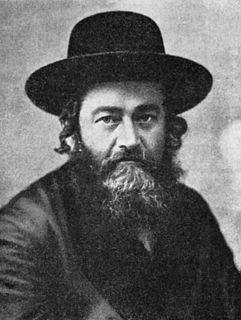Abraham Naftali Hertz Scheuer was a German Orthodox rabbi and kabbalist, born in Frankfurt am Main in 1753 to Rabbi David Tebele Scheuer and his second wife (daughter of Rabbi Nathan Otiz, rabbi of Bamberg).
He led his father's yeshiva in Mainz as its Rosh Yeshiva from 1778 until 1782, taking over from his brother Rabbi Mechel Scheuer. In 1811 he became Rabbi of Mainz where he died on October 10, 1822. [1] He is known for his halakhic ruling against the use of an organ in synagogues in the book Eleh Dibre ha-B'rit (Altona 1819).
Gershom ben Judah, best known as Rabbeinu Gershom and also commonly known to scholars of Judaism by the title Rabbeinu Gershom Me'Or Hagolah, was a famous Talmudist and Halakhist.

The Soloveitchik dynasty of rabbinic scholars and their students originated the Brisker method of Talmudic study, which is embraced by their followers in the Brisk yeshivas. It is so called because of the Soloveitchiks' origin in the town of Brisk, or Brest-Litovsk, located in what is now Belarus. Many of the first Soloveitchik rabbis were the official rabbis of Brisk, and each in turn was known as "the Brisker Rov". Today, Brisk refers to several yeshivas in Israel and the United States founded by members of the Soloveitchik family.

Yehuda Meir Shapiro, was a prominent Polish Hasidic rabbi and rosh yeshiva, also known as the Lubliner Rav. He is noted for his promotion of the Daf Yomi study program in 1923, and establishing the Chachmei Lublin Yeshiva in 1930.

Moses Schreiber (1762–1839), known to his own community and Jewish posterity in the Hebrew translation as Moshe Sofer, also known by his main work Chatam Sofer, Chasam Sofer, or Hatam Sofer, was one of the leading Orthodox rabbis of European Jewry in the first half of the nineteenth century.

Yaakov ben Moshe Levi Moelin was a Talmudist and posek best known for his codification of the customs (minhagim) of the German Jews. He is also known as Maharil - the Hebrew acronym for "Our Teacher, the Rabbi, Yaakov Levi" - as well as Mahari Segal or Mahari Moelin. Maharil's Minhagim was a source of law for Moses Isserles’ component of the Shulkhan Arukh.
Rabbi Isaac Elchanan Theological Seminary is the rabbinical seminary of Yeshiva University. It is located along Amsterdam Avenue in the Washington Heights neighborhood of Manhattan, New York City.
Joseph Saul Nathansohn (1808–1875) was a Polish rabbi and posek, and a leading rabbinical authority of his day.
Yaakov Yitzchok Ruderman was a prominent Talmudic scholar and rabbi who founded and served as rosh yeshiva of Yeshivas Ner Yisroel in Baltimore.
The Ten Martyrs were ten rabbis living during the era of the Mishnah who were martyred by the Roman Empire in the period after the destruction of the Second Temple. Their story is detailed in Midrash Eleh Ezkerah.
Zalman Sorotzkin, also known as the Lutzker Rav, was a famous Orthodox rabbi who served as the rabbi of Lutsk, Ukraine.
Joseph ben Solomon Ṭaiṭazaḳ, also referred to by the acronym MahaRITaTS, was a talmudic authority and kabalist who lived at Salonica in the 15th and 16th centuries. He was a member of the Taitazak family.

Yitzchak Yaacov Reines, was a Lithuanian Orthodox rabbi and the founder of the Mizrachi Religious Zionist Movement, one of the earliest movements of Religious Zionism, as well as a correspondent of Theodor Herzl.
Jacob Moses David Tebele Scheuer (1712–1782) was a German rabbi.
Rabbi Mechel Scheuer was a German Orthodox rabbi, born in Frankfurt am Main in 1739 to his father Rabbi David Tebele Scheuer. He led his father's Yeshiva in Mainz as its Rosh Yeshiva during the years 1776 and 1777. In 1778 he became rabbi of Worms and in 1782 was appointed rabbi of Mannheim; then as rabbi of Koblenz where he died in 1810

Midrash Eleh Ezkerah is an aggadic midrash, one of the smaller midrashim, which receives its name from the fact that a seliḥah for the Day of Atonement, which treats the same subject and begins with the words "Eleh ezkerah," recounts the execution of ten famous teachers of the Mishnah in the time of the persecution by Hadrian. The same event is related in a very ancient source, Eichah Rabbah.

Ishmael ben Elisha ha-Kohen was one of the prominent leaders of the first generation of the Tannaim.
Rabbi Joel ben Isaac ha-Levi also known as Rav Joel of Bonn was a 12th-century German Tosafist, and the father of Eliezer ben Joel HaLevi.
Yitzhak of Volozhin was a rosh yeshiva of the Volozhin Yeshiva.
Herman Bodek was a Galician Jewish Hebraist. He was descended from a highly respected family, and was the son-in-law of Solomon Judah Loeb Rapoport. For a long time he lived in Leipzig, where he was translator of Hebrew at the courts of law, and was also engaged in business.
Jakob Koppel Löwenstein was a German rabbi and writer in Baden.